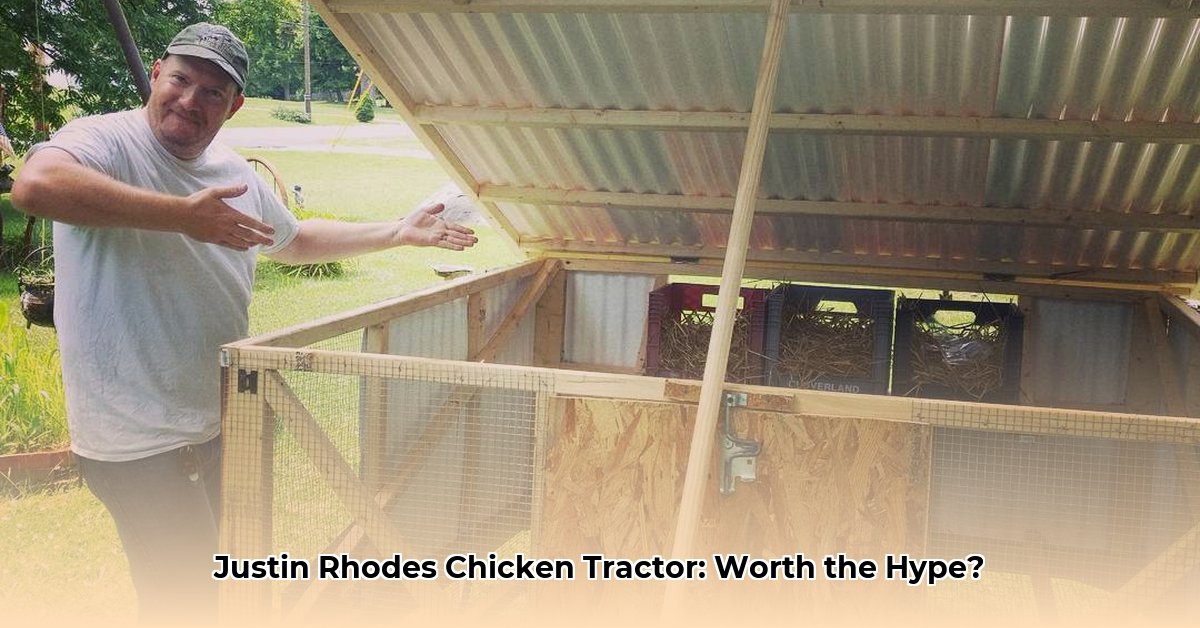
Choosing the right mobile chicken coop is crucial for sustainable backyard poultry farming. This review compares the Justin Rhodes handcrafted chicken tractor with the ChickShaw, analyzing design, cost, durability, ease of use, and environmental impact to help you make an informed decision. Both offer benefits for rotational grazing and improved soil health, but their approaches differ significantly. For more information on the Justin Rhodes model, check out this website.
Design and Construction: Robustness vs. Simplicity
The Justin Rhodes Chicken Tractor prioritizes durability. Its robust construction, often using high-quality wood, promises longevity and excellent predator protection. Think of it as a small, fortified home on wheels for your flock. However, this strength translates to increased weight and difficulty in moving it.
The ChickShaw, conversely, emphasizes portability. Its lighter design and often smaller size make relocation easier, even for a single person. This ease of movement simplifies rotational grazing. However, this lighter build might compromise its longevity and predator resistance compared to the Justin Rhodes model. Will its lighter frame withstand harsh weather or determined predators? Further research into long-term durability is needed.
Mobility and Effort: Muscle Power vs. Effortless Movement
Moving the Justin Rhodes Chicken Tractor requires more effort, often necessitating two people, especially on uneven terrain. This can be a significant factor, especially for those with limited physical strength or assistance. Is the increased durability worth the extra effort? That’s a question each potential buyer must answer.
The ChickShaw, designed for ease of movement, is often manageable by a single person. This significantly reduces the physical demand of rotational grazing. However, detailed testing is needed to determine its performance and stability on uneven ground and inclined terrain. Does this ease of movement come at the cost of stability?
Cost and Investment: Upfront Expense vs. Long-Term Savings
The Justin Rhodes Chicken Tractor's higher price reflects its premium materials and construction. While this represents a larger upfront investment, its potential for longer lifespan might offset this over time. Add to this the often required local pickup and potential transportation costs if you’re not near the builder.
The ChickShaw generally has a lower initial cost. However, remember to factor in the potential for earlier replacement or more frequent repairs. Does the lower initial cost translate to long-term savings? This depends heavily on the lifespan and maintenance requirements of each model.
Sustainability and Environmental Impact: Minimizing Your Footprint
Both coop designs promote the sustainable practice of rotational grazing, benefiting soil health and pest control. The Justin Rhodes model, focusing on local sourcing and potentially longer lifespan, may have a lower overall environmental impact. However, a comprehensive lifecycle assessment, considering material sourcing, manufacturing, transportation, and disposal, is needed to accurately compare their environmental footprints. Further research would allow for definitive conclusions on which contributes more to environmentally friendly practices.
Maintenance and Lifespan: Long-Term Care
The Justin Rhodes Chicken Tractor's durable materials might translate to lower maintenance needs over its lifespan, but repairs could be more complex. The ChickShaw, while needing more frequent minor maintenance (e.g., mesh repairs), offers simpler repairs. A long-term analysis comparing the total cost of maintenance and repairs for both models would be invaluable. Which will cost more in the long run?
A Step-by-Step Guide to Setting Up a Mobile Chicken Coop (Based on Justin Rhodes Design Principles)
Note: Adapt these steps to your chosen coop, always referring to the manufacturer’s instructions.
- Site Selection: Choose a level, well-drained area with ample pasture access, considering sun exposure and protection from wind.
- Assembly: Carefully follow the coop’s assembly instructions. Basic carpentry skills may be helpful for handcrafted models.
- Placement and Rotation: Strategically position the coop to maximize pasture utilization, following a rotational grazing plan (See sidebar for tips on rotational grazing).
- Chicken Introduction: Gradually introduce your hens to their new home to minimize stress.
- Regular Maintenance: Regularly inspect the coop for wear and tear, performing necessary repairs immediately.
Comparative Summary
| Feature | Justin Rhodes Chicken Tractor | ChickShaw |
|---|---|---|
| Portability | Low | High |
| Durability | High | Moderate |
| Predator Protection | High | Moderate |
| Initial Cost | High | Low |
| Maintenance | Lower frequency, potentially more complex | Higher frequency, simpler |
| Rotational Grazing | Excellent | Excellent |
Conclusion: Choosing the Right Coop for Your Needs
The decision between the Justin Rhodes Chicken Tractor and the ChickShaw depends on your priorities. The Justin Rhodes model prioritizes durability and predator protection at the cost of portability and initial expense. The ChickShaw emphasizes ease of use and mobility, potentially at the expense of long-term durability and predator defense. Consider your budget, physical capabilities, and long-term maintenance commitment to select the best model for your backyard flock.
Sidebar: Tips for Rotational Grazing
- Divide your pasture into sections.
- Move the coop to a fresh section every few days.
- Allow sufficient time for pasture regeneration between rotations.
- Observe your chickens' grazing habits to optimize rotations.
This detailed comparison, while providing a robust analysis, should be complemented with further research based on long-term testing of both coop designs under various conditions.